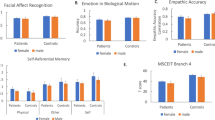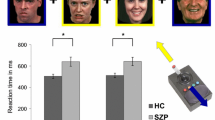Abstract
More than 80 % of patients diagnosed with schizophrenia are nicotine-dependent. Self-medication of cognitive deficits and an increased vulnerability to stress are discussed as promoting factors for the development of nicotine dependence. However, the effects of nicotine on social cognition and subjective stress responses in schizophrenia are largely unexplored. A 2 × 2-factorial design (drug × group) was used to investigate the effects of nicotine versus placebo in smoking schizophrenia patients and healthy controls after 24 h of abstinence from smoking. Participants performed a facial affect recognition task and a semi-standardized role-play task, after which social competence and self-reported stress during social interaction were assessed. Data analysis revealed no significant group differences in the facial affect recognition task. During social interaction, healthy controls showed more non-verbal expressions and a lower subjective stress level than schizophrenia patients. There were no significant effects of nicotine in terms of an enhanced recognition of facial affect, more expressive behaviour or reduced subjective stress during social interaction. While schizophrenia patients unexpectedly recognized facial affect not significantly worse than healthy controls, the observed group differences in subjective stress and non-verbal expression during social interaction in the role-play situation are in line with previous findings. Contrary to expectations derived from the self-medication hypothesis, nicotine showed no significant effects on the dependent variables, perhaps because of the dosage used and the delay between the administration of nicotine and the performance of the role-play.



Similar content being viewed by others
References
Carra G et al (2012) The lifetime and past-year prevalence of dual diagnosis in people with schizophrenia across Europe: findings from the European Schizophrenia Cohort (EuroSC). Eur Arch Psychiatry Clin Neurosci 262(7):607–616
de Leon J, Diaz FJ (2005) A meta-analysis of worldwide studies demonstrates an association between schizophrenia and tobacco smoking behaviors. Schizophr Res 76(2–3):135–157
McCreadie RG (2002) Use of drugs, alcohol and tobacco by people with schizophrenia: case–control study. Br J Psychiatry 181:321–325
Weiser M et al (2004) Higher rates of cigarette smoking in male adolescents before the onset of schizophrenia: a historical-prospective cohort study. Am J Psychiatry 161(7):1219–1223
Riala K et al (2005) Is initiation of smoking associated with the prodromal phase of schizophrenia? J Psychiatry Neurosci 30(1):26–32
Kumari V, Postma P (2005) Nicotine use in schizophrenia: the self medication hypotheses. Neurosci Biobehav Rev 29(6):1021–1034
Leonard S, Mexal S, Freedman R (2007) Smoking, genetics and schizophrenia: evidence for self medication. J Dual Diagn 3(3–4):43–59
Winterer G (2010) Why do patients with schizophrenia smoke? Curr Opin Psychiatry 23(2):112–119
Zabala A et al (2009) Cognitive performance and cigarette smoking in first-episode psychosis. Eur Arch Psychiatry Clin Neurosci 259(2):65–71
Balfour DJ, Fagerstrom KO (1996) Pharmacology of nicotine and its therapeutic use in smoking cessation and neurodegenerative disorders. Pharmacol Ther 72(1):51–81
Fidler JA, West R (2009) Self-perceived smoking motives and their correlates in a general population sample. Nicotine Tob Res 11(10):1182–1188
McKee SA et al (2011) Stress decreases the ability to resist smoking and potentiates smoking intensity and reward. J Psychopharmacol 25(4):490–502
DiFranza JR et al (2004) Recollections and repercussions of the first inhaled cigarette. Addict Behav 29(2):261–272
McKee SA et al (2003) Sex differences in the effects of stressful life events on changes in smoking status. Addiction 98(6):847–855
Buchmann AF et al Cigarette craving increases after a psychosocial stress test and is related to cortisol stress response but not to dependence scores in daily smokers. J Psychopharmacol 24(2):247–255
Baker A et al (2007) Characteristics of smokers with a psychotic disorder and implications for smoking interventions. Psychiatry Res 150(2):141–152
Gurpegui M et al (2007) Subjective effects and the main reason for smoking in outpatients with schizophrenia: a case–control study. Compr Psychiatry 48(2):186–191
Steen NE et al (2011) Increased systemic cortisol metabolism in patients with schizophrenia and bipolar disorder: a mechanism for increased stress vulnerability? J Clin Psychiatry 72(11):1515–1521
Jansen LM, Gispen-de Wied CC, Kahn RS (2000) Selective impairments in the stress response in schizophrenic patients. Psychopharmacology 149(3):319–325
Hahn B et al (2009) Performance effects of nicotine during selective attention, divided attention, and simple stimulus detection: an fMRI study. Cereb Cortex 19(9):1990–2000
Heishman SJ, Kleykamp BA, Singleton EG (2010) Meta-analysis of the acute effects of nicotine and smoking on human performance. Psychopharmacology 210(4):453–469
Hong LE et al (2009) Nicotine enhances but does not normalize visual sustained attention and the associated brain network in schizophrenia. Schizophr Bull 37(2):416–425
Smith RC et al (2006) Effects of nicotine nasal spray on cognitive function in schizophrenia. Neuropsychopharmacology 31(3):637–643
Sacco KA et al (2005) Effects of cigarette smoking on spatial working memory and attentional deficits in schizophrenia: involvement of nicotinic receptor mechanisms. Arch Gen Psychiatry 62(6):649–659
Brothers L (1990) The social brain: a project for integrating primate behavior and neurophysiology in a new domain. Concepts Neurosci 1:27–51
Fett AK et al (2011) The relationship between neurocognition and social cognition with functional outcomes in schizophrenia: a meta-analysis. Neurosci Biobehav Rev 35(3):573–588
Couture S, Penn DL, Roberts DL (2006) The functional significance of social cognition in schizophrenia: a review. Schizophr Bull 32:44–63
Pinkham AE et al (2003) Implications for the neural basis of social cognition for the study of schizophrenia. Am J Psychiatry 160(5):815–824
Kohler CG et al (2010) Facial emotion perception in schizophrenia: a meta-analytic review. Schizophr Bull 36(5):1009–1019
Meyer MB, Kurtz MM (2009) Elementary neurocognitive function, facial affect recognition and social-skills in schizophrenia. Schizophr Res 110(1–3):173–179
Hofer A et al (2009) Facial emotion recognition and its relationship to symptomatic, subjective, and functional outcomes in outpatients with chronic schizophrenia. Eur Psychiatry 24(1):27–32
Aghevli MA, Blanchard JJ, Horan WP (2003) The expression and experience of emotion in schizophrenia: a study of social interactions. Psychiatry Res 119(3):261–270
Brune M et al (2008) Nonverbal behavior during standardized interviews in patients with schizophrenia spectrum disorders. J Nerv Ment Dis 196(4):282–288
Gaebel W, Wölwer W (1992) Facial expression and emotional face recognition in schizophrenia and depression. Eur Arch Psychiatry Clin Neurosci 242(1):46–52
Gaebel W, Wölwer W (2004) Facial expressivity in the course of schizophrenia and depression. Eur Arch Psychiatry Clin Neurosci 254(5):335–342
Healey KM et al (2010) Do we recognize facial expressions of emotions from persons with schizophrenia? Schizophr Res 122(1–3):144–150
Bentley P et al (2003) Cholinergic enhancement modulates neural correlates of selective attention and emotional processing. Neuroimage 20(1):58–70
Newhouse PA et al (2011) Functional brain imaging of nicotinic effects on higher cognitive processes. Biochem Pharmacol 82(8):943–951
Mansvelder HD, Mertz M, Role LW (2009) Nicotinic modulation of synaptic transmission and plasticity in cortico-limbic circuits. Semin Cell Dev Biol 20(4):432–440
Stein EA et al (1998) Nicotine-induced limbic cortical activation in the human brain: a functional MRI study. Am J Psychiatry 155(8):1009–1015
Granon S, Faure P, Changeux JP (2003) Executive and social behaviors under nicotinic receptor regulation. Proc Natl Acad Sci USA 100(16):9596–9601
Trezza V, Baarendse PJ, Vanderschuren LJ (2009) Prosocial effects of nicotine and ethanol in adolescent rats through partially dissociable neurobehavioral mechanisms. Neuropsychopharmacology 34(12):2560–2573
Van Kampen M et al (2004) AR-R 17779 improves social recognition in rats by activation of nicotinic alpha7 receptors. Psychopharmacology 172(4):375–383
First MB et al (1995) Structured clinical interview for DSM-IV Axis I disorders, patient edition (SCID-P), version 2 edn. New York State Psychiatric Institute, Biometrics Research, New York
Warbrick T et al (2011) Direction and magnitude of nicotine effects on the fMRI BOLD response are related to nicotine effects on behavioral performance. Psychopharmacology 215(2):333–344
Lindenberg A et al (2011) The German multi-centre study on smoking-related behavior: description of a population-based case–control study. Addict Biol 16(4):638–653
Heatherton TF et al (1991) The fagerstrom test for nicotine dependence: a revision of the fagerstrom tolerance questionnaire. Br J Addict 86(9):1119–1127
Lehrl S (2005) Mehrfachwahl-Wortschatz-Intelligenztest MWT-B. Spitta, Balingen
Ekman P, Friesen WV (1976) Pictures of facial affect. Consulting Psychologists Press, Palo Alto
Bellack AS, Brown CH, Thomas-Lohrman S (2006) Psychometric characteristics of role-play assessments of social skill in schizophrenia. Behav Ther 37(4):339–352
Sayers MD et al (1995) An empirical method for assessing social problem solving in schizophrenia. Behav Modif 19(3):267–289
Fydrich T, Bürgener F (1999) Ratingskala für soziale Kompetenz. In: Margraf J, Rudolf K (eds) Soziale Kompetenz—Soziale Phobie: Anwendungsfelder, Entwicklungslinien, Erfolgsaussichten. Schneider, Baltmannsweiler, pp 81–96
Landis JR, Koch GG (1977) The measurement of observer agreement for categorical data. Biometrics 33(1):159–174
Janke W et al (1999) Befindlichkeitsskalierung anhand von Kategorien und Eigenschaftswörtern (BSKE). Institutsbericht, Psychologisches Institut, Universität Würzburg
Abt K (1987) Descriptive data analysis: a concept between confirmatory and exploratory data analysis. Methods Inf Med 26(2):77–88
Mancuso F et al (2011) Social cognition in psychosis: multidimensional structure, clinical correlates, and relationship with functional outcome. Schizophr Res 125(2–3):143–151
Bowie CR, Gupta M, Holshausen K (2011) Disconnected and underproductive speech in schizophrenia: unique relationships across multiple indicators of social functioning. Schizophr Res 131(1–3):152–156
Meyer MB, Kurtz MM (2009) Elementary neurocognitive function, facial affect recognition and social-skills in schizophrenia. Schizophr Res 110(1–3):173–179
Pinkham AE, Penn DL (2006) Neurocognitive and social cognitive predictors of interpersonal skill in schizophrenia. Psychiatry Res 143(2–3):167–178
Sparks A et al (2010) Social cognition, empathy and functional outcome in schizophrenia. Schizophr Res 122(1–3):172–178
Bowie CR et al (2007) Self-assessment of functional status in schizophrenia. J Psychiatr Res 41(12):1012–1018
Bell M et al (2009) Neurocognition, social cognition, perceived social discomfort, and vocational outcomes in schizophrenia. Schizophr Bull 35:738–747
Streit M et al (2001) EEG-correlates of facial affect recognition and categorisation of blurred faces in schizophrenic patients and healthy volunteers. Schizophr Res 49(1–2):145–155
Streit M et al (2003) Time course of regional brain activations during facial emotion recognition in humans. Neurosci Lett 342(1–2):101–104
Wölwer W et al (2012) Neurophysiological correlates of impaired facial affect recognition in individuals at risk for schizophrenia. Schizophr Bull 38(5):1021–1029
Kalman D, Smith SS (2005) Does nicotine do what we think it does? A meta-analytic review of the subjective effects of nicotine in nasal spray and intravenous studies with smokers and nonsmokers. Nicotine Tob Res 7(3):317–333
Benowitz NL et al (1982) Interindividual variability in the metabolism and cardiovascular effects of nicotine in man. J Pharmacol Exp Ther 221(2):368–372
Brekke J et al (2005) Biosocial pathways to functional outcome in schizophrenia. Schizophr Res 80(2–3):213–225
Acknowledgments
This study was funded by the German Research Association (DFG, grant no. WO 640/3-1) within the Priority Program 1226 ‘Nicotine: Molecular and physiological effects in the central nervous system’. The authors would like to thank our students Claudia Wach, Katharina Karakatsani and Abdelhadi Faraj for their support in conducting the study, in particular the role-play test. Additionally, we thank the Coordination Centre for Clinical Trials Düsseldorf, especially Marie-Therés Düsterhus for her support in particular in the recruitment of the healthy participants of the sample. We also thank Jacquie Klesing, ELS, for editing assistance with the manuscript.
Conflict of interest
None.
Author information
Authors and Affiliations
Corresponding author
Rights and permissions
About this article
Cite this article
Drusch, K., Lowe, A., Fisahn, K. et al. Effects of nicotine on social cognition, social competence and self-reported stress in schizophrenia patients and healthy controls. Eur Arch Psychiatry Clin Neurosci 263, 519–527 (2013). https://doi.org/10.1007/s00406-012-0377-9
Received:
Accepted:
Published:
Issue Date:
DOI: https://doi.org/10.1007/s00406-012-0377-9





